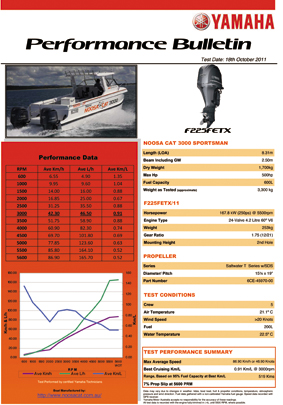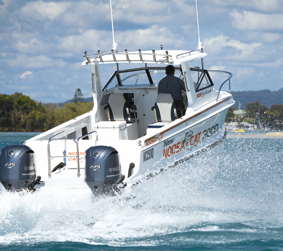THE EASE OF YAMAHA
- NAFA
- Feb 1, 2012
- 4 min read
Performance information is paramount to the decision-making process leading up to the purchase of a boat. Yamaha addresses this by sending out a technician to assemble what it calls a “Performance Bulletin” on engine/hull combinations that are particularly interesting and/or combinations which will give potential customers reliable information about how they can expect Yamaha power to perform on their own boat.
Buying an outboard motor is never a simple process. In 2012, outboard motors enjoy unprecedented levels of performance and reliability. We’ve literally never had it so good and that only makes choosing a motor from amongst the leading brands all the harder. However, there are lots of decisions to be made along the way before you get to the big one and put your money on the line.
Looking at engine weights, their physical size relative to their rated power and assessing your local dealer (and how the service they provide stacks up against their opposition) are all critical in swaying your dollars one way or another. But beyond that, you’re left in a no-man’s land of old-fashioned loyalty, opinion and information which may, or may not, be reliable.
Ideally, what you need is reliable information which at best would compare directly the performance and fuel consumption of the outboard options on your boat, the boat YOU fish from.
That’s virtually impossible of course! But, what is worth enquiring about from the salesman is what information they can offer about the performance and fuel consumption of motors you’re looking at on similar boats. Be careful though: often the data available will be from overseas, and as such it can be open to what I can only call “lateral interpretation”.
One exception is Yamaha outboards. Obviously it’s impossible for even a company with the logistical clout of Yamaha to test every motor it sells on every model boat they are fitted to. However, what Yamaha does here in Australia is to send out a technician to assemble what it calls a “Performance Bulletin” on engine/hull combinations that are particularly interesting and/or combinations which will give potential customers reliable information about how they can expect Yamaha power to perform on their own boat.
One of these Performance Bulletins is about a new Noosa Cat model fitted with twin Yamaha F225 V6 4 strokes. It is written so readers can see what the Yamaha can do. It’s an interesting data set in its own right for anyone interested in boats in general. But I’d suggest it’s a critical data set for people contemplating twin F225s, particularly if you’re thinking about powering a cat. And it is still interesting data for anyone wanting to compare an F225 in any way shape or form. So what do these Yamaha Service Bulletins tell us?
Yamaha’s F225 is the smallest (horsepower) motor built on a 4.2L V6 powerhead shared with the F250 and F300. At 253kg, the F225 is right in there with Suzuki’s 263kg 3.6L V6 DF225; Evinrude’s 3.3L V6 direct injected 2 stroke E-Tec E225 weighing 232kg; and Honda’s 267kg 3.5L V6 BF225.
I rode along with Yamaha technician Glenn Gibson and Noosa Cat’s Wayne Hennig while they were compiling the Performance Bulletin. Whilst it speaks for itself in so many ways, what most impressed me about the boat/power combination, on a purely seat-of-the-pants basis, wasn’t so much flat-out top-speed but the sheer “grunt” the whisper-quiet F225s delivered across the low-to-mid range of the power spectrum. I’ve been in ski boats with a whopping great V8 amidships that needed more time and distance to get away from a standing start than those Yammies did pushing 3.3 tonnes of Noosa Cat with 5 adults aboard. I guess that’s what you get out of 4.2L when the opposition’s a bit smaller...
The picture of the Noosa Cat used here was shot on another day entirely and, as a photographer, I’ve never been so glad I wasn’t responsible for any pretty pictures on the day we went out. In a word, the weather was feral. Periodic showers dampened the fun while odd wind gusts around 30 knots provided a little something extra on a day when a typical southern Queensland 20-25 knot south easterly screamed around Hell’s Gates at the end of Noosa’s spectacular sandstone headland.
Thankfully, the Noosa bar wasn’t too bad despite a swell sufficient to have the surf breaks nearly as packed as the National Park Lookouts where spectators crowd each other to watch the fun a “big day” provides. Wayne and Glenn faced quite a few difficulties finding enough smooth water for higher rev runs to peak out.
Yamaha’s Performance Bulletin data is an average of several runs in different directions and I can tell you the 86.9km/hr (46.9 knots) at 5600 top speed is a tad conservative because some of the runs were conducted inside the river on calm water where there’s more “drag” between the hull and the water. Offshore, surface chop breaks the “stiction” and that’s when a good power catamaran like a Noosa Cat really flies.
I saw 50 knots (92.6km/hr) on the GPS whilst Wayne ran at the “¾ across the back of the waves” angle that Noosa Cats just love. We were fairly rocketing along, as only a Noosa Cat can, after starting a flat-out-run amongst the surfers in the headland’s sheltering lee and it seemed like mere seconds before we were passing the back of the white water on the bar.
We had extra two blokes aboard for the test run and you could have scraped their eyebrows off the hardtop after the first of those. But as one of them said to me afterwards, if they weren’t impressed after a few flat out runs down sea, they certainly were when Wayne ran back at that awkward ¾ angle into the sea with the GPS “only” showing 30 knots - while we stood around talking, holding on with one hand.
If readers aren’t impressed already, let me point out that the fuel consumption figures on the Performance Bulletin are TOTAL fuel being burned by BOTH motors. This is where that mid-range “grunt” I was talking about before shows up on paper. Look at the figures when the motors were spinning at 3500rpm: 51.75km/hr (call it 27.9 knots if you prefer) and the F225s were burning under 60L per hour between them. If only data like this were available from every outboard brand, it’d be much easier to make those buying choices...








